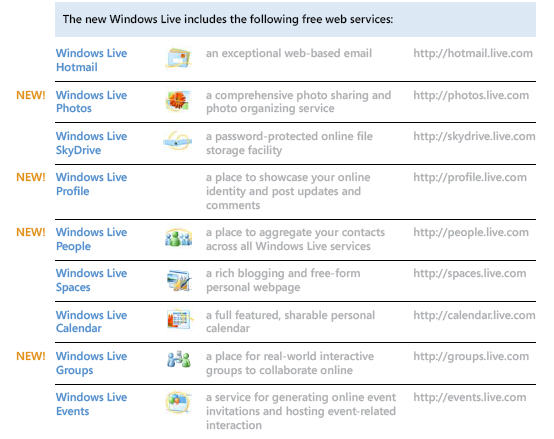Windows Live Wave 3: Microsoft's kinder and simpler consumer services strategy?

Microsoft announced Thursday its rollout plans for what's been known as "Windows Live Wave 3" -- the latest incarnation of the myriad Windows Live consumer-focused services.
Company officials say the goal with the new release -- which will be phased in over the next several months -- is to simplify Windows Live (Techmeme). That's an admirable and formidable goal, given the branding and positioning problems Windows Live has faced for the past few years.
Even under the new kinder, gentler Windows Live regime, there are still a LOT of confusingly named and seemingly overlapping Windows Live services in Microsoft's arsenal. Here's a partial list, from the Windows Live Reviewers Guide:
Some of the Windows Live services are considered "rich" services, which seems to mean they have a software and a services component. Examples: Windows Live Photo Gallery, Windows Live Writer, Windows Live Mail, Windows Live Movie Maker. (These "rich "services are part of the Microsoft Windows Live Essentials suite. The latest version of these Essential services are considered by the Softies to part of the Windows Live Wave 3 family.) The Essential services are the ones that will be complementary to Windows 7, replacing a number of the formerly bundled Windows applets, like Mail, Movie Maker, etc.
Then there are a bunch of Windows Live Wave 3 services that are purely services, with no software component. Examples: Windows Live Skydrive, Windows Live Sync (a k a Foldershare), Windows Live Photos (which is different from Windows Live Photo Gallery) and Windows Live Hotmail (which is different from Windows Live Mail). And Windows Live Messenger is part of both the "rich" family and the services-only family in Microsoft's latest taxonomy.
(Yeah, I am still confused, too. Even after getting to page through the 35-page Windows Live Reviewers guide.)
All of these Windows Live Wave 3 services are not available immediately. They are being rolled out over a period of months.
Some -- such as Windows Live Hotmail -- have a nearly six-month planned rollout schedule. Phase one of the new Wave 3 Hotmail started rolling out in September. POP mail access isn't slated to start rolling out as part of Hotmail Wave 3 for a few more months (Q1 or so in 2009).
Here's the rollout schedule from the Reviewers Guide:
As if all this weren't confounding enough, there are a bunch of brand-new elements that Microsoft is introducing as part of its Windows Live Wave 3 strategy. I'm not saying these aren't interesting/useful pieces of the Live puzzle. I just find them confusing because they are being lopped into the wider Wave 3 announcement.
First, Microsoft is de-emphasizing Windows Live Spaces. Existing Spaces don't disappear. But now Microsoft is repositioning the centralized Windows Live user profile areas as the revamped start.live.com sites. Users' start.live.com page will look a lot like Facebook, with a centralized activity feed. Check it out (click on the image to magnify it):
Sharing user data with one's network of contacts if optional and can be opted out of at a granular level.
Microsoft also is announcing as part of its Wave 3 launch that it has signed up a number of partners willing to allow an exchange of user data between their sites and Windows Live. Among the partner sites with whom Windows Live users will be able to share their data are Flickr, iLike, Pandora, PhotoBucket Twitter, Yelp and more. (Missing from the list, as a few bloggers have noted, are Facebook and MySpace, both of which have been doing their best to keep their Web 2.0 communities walled gardens.)
Microsoft is introducing its cleaned-up and relaunched Windows Live Groups as part of the Wave 3 unveiling. It also is acknowledging the renaming of FolderShare as "Windows Live Sync," although not doing much to explain why you'll need Sync once Live Mesh becomes incorporated into the Windows Live platform fabric.
So there you have the 50,000-foot overview. Microsoft has a big Windows Live mess to clean up and it will, no doubt, take several more waves to do so.
In the interim, what do you think of the latest strategy/deliverables on the Windows Live front?
